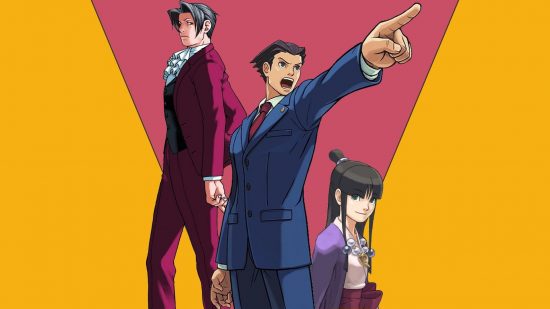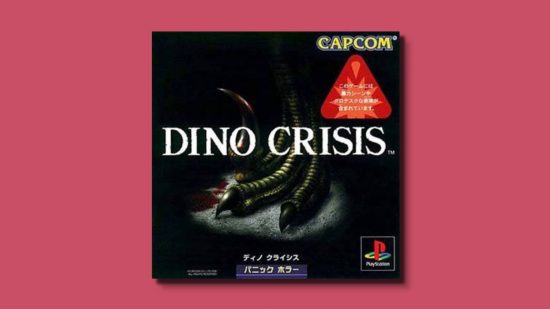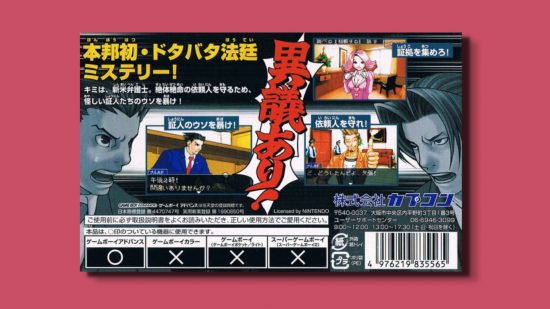Phoenix Wright: Ace Attorney is a visual novel adventure mystery game developed and published in Japan by Capcom for the Game Boy Advance under the name Gyakuten Saiban (Turnabout Trial) in 2001. In 2005, Capcom localised the game for release on the Nintendo DS worldwide.
Written and directed by Shu Takumi, produced by Atsushi Inaba, with music by Masakazu Sugimori, character designs by Kumiko Suekane, and art by Tatsuro Iwamoto, Ace Attorney is an exquisite piece of videogame storytelling. And it’s only the work of a team of seven people over ten months.
Since those humble beginnings, we’ve seen ten entries in the series; a live-action film, anime, and manga; numerous novels, stage plays, and musicals; as well as crossovers with series such as Marvel vs. Capcom and Monster Hunter. There is even a theme park attraction for the Ace Attorney series.
So, Ace Attorney is a franchise. There’s merchandise and rabid fans, reinterpretations and tie-ins – the series is a big deal. But, why did Capcom greenlight a law-based drama that takes you between offices and courtrooms? How did Shu Takumi go from being fired as director of Dino Crisis – a prehistoric horror action game created by Resident Evil’s Shinji Mikami – to making a visual novel? What inspired the game in the first place? And, why did Capcom localise it? Well, it’s an interesting story, so I’m here to tell it.
Luckily, Takumi is very open, conducting a bunch of interviews, so we know a lot about this time. The excellent Gyakuten Saiban library has loads of info, while the Court-Records Forums is also a good place to go – just in case you want to explore.
Shu Takumi joined Capcom in 1994, at the same time as Hideki Kamiya – the Okami creator who would go on to found Platinum Games with Shinji Mikami – where he worked as a planner. This interview with Takumi reveals a lot from the early days, when his first job was working on a videogame adaptation of the anime Gakkō no Kowai Uwasa: Hanako-San ga Kita!! as a planner. After that, things become a bit of a mishmash.
“There was a two, three-year blank. This was a period where we kept coming up with new plans, which also kept falling apart. The plans went everywhere, from a music game to an educational game, and I also came up with a project for a detective game which would be the prototype for Ace Attorney. My boss at the time quit, and I was picked up by the producer of the Biohazard team, and thus came to join Production Studio 4 (as it was called at the time).”
This Capcom Production Studio 4 was Shinji Mikami’s team, where Takumi worked on the first version of Resident Evil 2, which was eventually scrapped and started from the beginning; “unfortunately, the part we worked on wasn’t preserved. Doesn’t really matter though.”
From there, he became the director of Dino Crisis – an ill-fated appointment. “They made me director of Dino Crisis, but now I look back, I don’t think I even knew what it meant to be a “director”. Because of that, I put the team in confusion and was fired as the director…”
So, Capcom demoted him to planner, before making him the director again for the sequel: “they decided to make Dino Crisis 2 and for some reason, they made me director again. I have no idea whether the producer was extremely kind, or just forgetful (laugh). Anyway, I reflected deeply on myself during the development of the first game, and changed my way of working and thinking.”
This second chance went a lot better for Takumi, and as a reward, Capcom told him, ‘we’ll give you half a year to go make whatever you want,’ – “I guess this was a little bonus for me having done my best on the Dino Crisis series for three years.” So, with six months and a detective game concept in the back of his mind from the early years, this was Takumi’s chance.
Taking this original detective game concept, Takumi had a small team of seven and less than a year to work with. “It was a team comprising of new people with little experience on the job, and even though there were just the seven of us, we made a lot of trouble”, he said; “we were just making this game somewhere hidden away in the corner of the company, so there was no pressure at all, and we could work rather relaxed.
“We were all young and we poured our all into it (without thinking about what our limits would be), but now I think about it, I’m amazed just two people managed to create all the graphical assets and two programmers did the whole thing. And I was the planner, scenario writer and the director in one. I could not have imagined that this game would be going on even now.”
At one point during development, when they showed the first playable version of the game to higher-ups, things didn’t go well. “It’s not fun”… a simple quote from a blog post in 2001. And, while his bosses didn’t like the game, Takumi had another issue on his hands:
“It happened at the end-of-the-year party of Production Studio 4. I had promised to do a magic show in front of about a hundred drunken men. I’ll leave out why things had turned out that way, but I had said I would, and I have my own pride, so I’d definitely have to surprise them.
“‘What am I supposed to do?’ As I was thinking sadly about that in my mind, I was making a silver orb float in the air, cutting a beautiful woman in half, and making the Capcom building disappear (partially exaggerated).
“And so the twentieth century was about to end.”
After this fretful magic show, one of the team of seven left due to personal reasons, throwing development into further turmoil. Still, by some magic, this tiny team got the game done in ten months. Stories from the time paint the picture of a scrappy, low-budget endeavour. But the difficulty wasn’t just reserved to actually making the thing, as this 2019 blog post reflects. Getting people on board in the first place was hard enough.
“There were no courtroom-based games at the time, so it was very hard to convey to others what it would actually play like. When I first presented the game’s concept to the higher-ups in the company, I received a lot of negative comments like, ‘this game seems hard and unforgiving. Are you sure players will take to this?’ and ‘won’t players need some legal knowledge just to play?’”
But, for Takumi, “the point was to have fun solving puzzles and enjoy the excitement of calling witnesses out in their lies with evidence.” This is where the game marks itself out somewhat. Sure, visual novels and point-and-click adventures had storytelling and puzzle-solving at the same time, but not quite like this.
While the story is told through traditional visual novel techniques, there are also point-and-click adventure elements in exploring different places to find evidence, meet new characters, and uncover more of the mystery. But rather than leave it there, Ace Attorney has a final part – the courtroom.

To end an episode, you must use the correct evidence to catch the guilty party out. Gameplay-wise, this isn’t exactly advanced in the first game, but it does add that satisfying feeling of piecing together evidence, something that was key for Takumi.
“The real fun behind mystery stories lies in the logic when you connect all the hints and solve the mystery”, he said in a conversation with mystery writer Ookura Takahiro. And that’s one of the key elements that helps Ace Attorney stand out. It’s something that made me think of Danganronpa, a game that didn’t come out until 2010.
That game’s creator, Kazutaka Kodaka, actually highlighted the step beyond visual novels that Ace Attorney made, in an interview with USgamer; “I’d like to draw a distinction between visual novels and something like Phoenix Wright […] When you look at Phoenix Wright and Danganronpa, you actually see gameplay elements, and that’s what made these games catch on. I feel there’s a big opportunity in America for visual novels, but that depends on how much gameplay developers are able to incorporate into them.”
This incorporation of gameplay is arguably the key to Ace Attorney’s success. And, given its success, it’s hard to imagine a world with Danganronpa were it not for that six months of free rein given to Shu Takumi.
So, while Ace Attorney may have inspired countless classics after it, its inspirations are, naturally, a little different. There’s obviously Columbo, a series Takumi loves a whole lot; “I used to record the audio of Columbo episodes on a cassette tape and listen to them in my room.”
Meanwhile, Perry Mason – a criminal defence lawyer in a series of novels from Erle Stanley Gardner published between 1933 and 1973 – is such a big influence the game references it with the MASON system in Apollo Justice. In an interview for Famitsu translated by GoNintendo, Takumi expanded:
“[Perry Mason is] the story of someone who investigates, takes testimonies, and gathers evidence all by himself. Then he stands in the courtroom to expose lies and defend the innocence of his clients. When I was first planning Ace Attorney my initial idea was to have the protagonist be a private detective […] but then the lawyer Perry Mason came to mind.”
This gave Takumi that key gameplay element that helps the series stand out; “You would be fighting other lawyers to protect your client and there would be a judge present as an adjudicator, as well as those in the stands going crazy. That really suited the series as an arena for battle.”

But it also gave Takumi another thing – the ability to write. Now, I don’t speak Japanese, but by everything I’ve read Shu Takumi’s writing on the games is sharp and strange, witty and nuanced, and the mysteries are gripping. While, of course, a key element, it does make one aspect of videogame making very tricky. How do you localise something like this? Or, rather, why did they localise this videogame?
This isn’t me saying it’s a bad decision, but that it’s a strange decision. Capcom was and still is a massive business, things which are not famous for spending money where it isn’t needed. And then there’s the genre, a niche to say the least, and a hard sell at that, plus the setting – this game is set in Japan (something changed in localisation). But, most importantly, this game has a lot of text.
So, how do you sell a game with law, courtrooms, Japanese cultural references, and walls of text to a foreign audience? No matter how successful Ace Attorney was at the time in Japan, exporting was definitely a different kettle of fish.
So, while the creation of the game and clever innovation is cool and everything, I think the bigger miracle is the fact that it got localised at all. Sure, it took four years after its GBA release, but it still made it. It’s a big job, after all – it took six years for The Great Ace Attorney Chronicles to come out outside of Japan.
Alex Smith led the localisation, and in an interview with USgamer, it becomes clear how tough a job it was. “My original suggestion for Phoenix Wright[‘s name] was ‘Roger Wright.’ […] ‘Wright,’ I felt, had to be his last name, because of the pun in Japanese… ‘Naruhodo’ [Phoenix’s surname in Japan, meaning “I see” or “I understand”] was used so many times in the text as a joke.”
But it’s not just names, it’s places too. Ace Attorney is set in Japan, and clearly so, with cultural references littered throughout. But, instead of being vague about its setting and morphing the references into something an unacquainted audience could understand, the localisation team had to give a definitive answer.
“The specificity of the setting had to be made because there was an episode where this guy has some sort of clock his girlfriend gave him. It had to be set to some time zone, and we were like, ‘Oh, crap. I guess we have to be specific about it.’ So we just chose that without really thinking that much about it.” This had led to issues in follow-up games, but it goes to show just how complex game localisation can become. Just the tiniest details can change a whole lot.

So, as you may have already guessed, I see Phoenix Wright as some sort of tripartite miracle. Firstly, Shu Takumi’s kernel of an idea was lucky enough to be explored, thanks to a kindly six-month freedom reward from higher-ups. Secondly, the game pushes visual novels forward in a remarkable way – one which makes it hard to call Ace Attorney a VN. And, thirdly, Capcom not only decided to localise it, but it also managed to in a way that endeared itself to a broad audience.
It may not seem that amazing, but just look at what it sparked. Sure, the countless sequels and spin-offs should be enough, but it’s more than that. There’s the Ace Attorney musical, stage plays, and novels, as well as a theme park attraction. It’s unbelievable that such humble, difficult beginnings could create such a rabid fanbase.
And, of course, there’s Shu Takumi, still at Capcom while Hideki Kamiya and Shinji Mikami have all moved on to different places. What is he doing now? His last Ace Attorney game came out in 2017. The only other credit I can find is as a quest writer for the mobile game Monster Hunter Riders (a quest called Giovanni, apparently, though the best Ace Attorney crossover in that game is the comically large pointing arm).
What does Shu Takumi do next? Where does the Ace Attorney series go? With the original trilogy and The Great Ace Attorney Chronicles revitalising the series, it feels like there’s more than enough interest. Yet it also feels like we’d have some news by now – it’s been more than five years.
Anyway, all that goes to say is that I like Ace Attorney, and you might too. There’s so much more to discover beyond the first game, not just within the games, but the anecdotes around them too, and so many more creators beyond Shu Takumi. Dive in, and you might just get a little lost (in the best way possible).
So, that’s our Phoenix Wright: Ace Attorney history lesson over then, class. Maybe we could take a look at Monster Hunter, alongside Auto Modellista and Resident Evil Outbreak? Or we could leave Capcom behind and return to Sega after our Castlevania: Bloodlines history lesson, and look at the wonderful work of Rieko Kodama, to talk about Phantasy Star. Well, I guess we’ll just have to wait and see, but one thing’s for certain: I’ll be back whether you like it or not.






